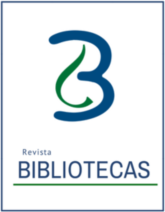Design Thinking for the Teaching of Library and Information Sciences
DOI:
https://doi.org/10.15359/rb.38-2.1Keywords:
librarianship, academic teaching, Design thinkingAbstract
The mayor aim of this study is to present the design thinking as a methodology to improve teaching scenarios and to investigate about its implementation in library and information sciences teaching. This work has been developed with an extensive bibliographical review of journal articles, books, web sites of organizations that are leading in this subject and conference proceedings that were found in academic databases. It has been found that there is a large evidence of its successful implementation in academic teaching, nevertheless, there is few information concerning library and information sciences teaching and in Spanish language, even though it is a methodology that can improve the teaching strategies in this discipline, fostering the constructivism.
References
Armstrong, C. (2016). Teaching innovation through empathy: Design thinking in the undergraduate business classroom. Management Teaching Review, 1 (3). DOI https://doi.org/10.1177/2379298116636641
Beckman, S. y Barry, M. (2007). Innovation as a learning process: Embedding design thinking. California Management Review, 50(1). DOI https://doi.org/10.2307/41166415
Bowler, L. (2014). Creativity through “maker”: Experiences and design thinking in the education of librarians. Knowledge Quest, 42 (5).
Buchanan, R. (1992). Wicked problems in design thinking. Design Issues, 18 (2). Recuperado de http://web.mit.edu/jrankin/www/engin_as_lib_art/Design_thinking.pdf
Clarke, R., Bell, S. (2018). Transitioning from the MLS to the MLD: Integrating design thinking and philosophy into library and information science education. En Re-envisioning the MLS: Perspectives on the future of Library and Information Science Education (Advances in Librarianship, Volume 44A), editado por Johnna Percell, Linday C. Sarin, Paul T. Jaeger y John Carlo Bertot. Estados Unidos: Emerald Publishing. Recuperado de https://surface.syr.edu/cgi/viewcontent.cgi?article=1174 HYPERLINK "https://surface.syr.edu/cgi/viewcontent.cgi?article=1174&context=istpub"& HYPERLINK "https://surface.syr.edu/cgi/viewcontent.cgi?article=1174&context=istpub"context=istpub
Coleman, M.C. (2016). Design thinking and the school library. Knowledge Quest, 44 (5). Recuperado de https://files.eric.ed.gov/fulltext/EJ1099478.pdf
Escobar, M., Infante, M. (2018). La formación competente del profesional de la bibliotecología y las ciencias de la información. Transformación 14 (1). Recuperado de http://scielo.sld.cu/scielo.php?script=sci_abstract HYPERLINK "http://scielo.sld.cu/scielo.php?script=sci_abstract&pid=S2077-29552018000100002"& HYPERLINK "http://scielo.sld.cu/scielo.php?script=sci_abstract&pid=S2077-29552018000100002"pid=S2077-29552018000100002
Gardner, L. (2017a). How design thinking can be applied across the campus. The Chronicle of Higher Education. Recuperado de https://www.chronicle.com/article/How-Design-Thinking-Can-Be/241127
Gardner, L. (2017b). Can design thinking redesign higher ed? The Chronicle of Higher Education. Recuperado de https://www.chronicle.com/article/Can-Design-Thinking-Redesign/241126
Hasso Plattner Institute of Design at Stanford (s.f). Miniguía: Una introducción al design thinking. Traducido por Felipe González. Recuperado de https://dschool-old.stanford.edu/sandbox/groups/designresources/wiki/31fbd/attachments/027aa/GU%C3%8DA%20DEL%20PROCESO%20CREATIVO.pdf?sessionID=8af88fee76ecd1fb7879c915073461486c425622
IDEO (2013). Design thinking for educators. Recuperado de https://designthinkingforeducators.com/
IDEO (2014). Design thinking for libraries: A toolkit for patron-centered design. Recuperado de http://designthinkingforlibraries.com/
Interaction Design Foundation (2018a). Design thinking: Get a quick overview of the history. Recuperado de https://www.interaction-design.org/literature/article/design-thinking-get-a-quick-overview-of-the-history
Interaction Design Foundation (2018b). Design thinking: A quick overview. Recuperado de https://www.interaction-design.org/literature/article/design-thinking-a-quick-overview
Koh, J., Chai, C., Wong, B., Hong, H. (2015). Design thinking for education: Conceptions and applications in teaching and learning. Singapore: Springer.
Leverenz, C. (2014). Design thinking and the wicked problem of teaching writing. Computers and Composition, 33. DOI https://doi.org/10.1016/j.compcom.2014.07.001
Lor, R. (2017). Design thinking in education: A critical review of literature. En: Asian Conference on Education & Psychology, Bangkok, Thailandia. Recuperado de https://www.researchgate.net/publication/324684320_Design_Thinking_in_Education_A_Critical_Review_of_Literature
Luka, I. (2014). Design thinking in pedagogy. Journal of Education Culture and Society, 2. Doi:10.15503/jecs20142.63.74
Monfasani, R. M. (2016). Introducción a la bibliotecología. Argentina: Alfagrama.
Mora, M. (2010). La teoría de la mente en el contexto de la teoría dinámica de la tropa y sus aportes a la educación. Revista Educación, 32 (2). Recuperado de https://revistas.ucr.ac.cr/index.php/educacion/article/view/489/483
Newberry, J. (2016). Adventures in teaching millennials: Population health, community engagement, and design thinking for first year medical students. Annals of Emergency Medicine, 68 (4).
Organización de las Naciones Unidas para la Educación, la Ciencia y la Cultura (2009). Conferencia Mundial sobre la Educación Superior - 2009: La nueva dinámica de la educación superior y la investigación para el cambio social y el desarrollo. París. Recuperado de http://www.unesco.org/education/WCHE2009/comunicado_es.pdf
Pirela, J., Pulido, N. (2017). Tendencias para la educación superior en sistemas de información, bibliotecología y archivística. Opción: Revista de Ciencias Humanas y Sociales, 33 (82), Recuperado de https://dialnet.unirioja.es/servlet/articulo?codigo=6233633
Ríos-Ortega, J. (2008). Didáctica de la bibliotecología: Teoría y principios desde la enseñanza de la ciencia. México: Universidad Autónoma de México.
Rosa, K., Storey, T. (2016). American libraries in 2016: creating their future by connecting, collaborating and building community. IFLA Journal, 42 (2).
Sabor, J. (1968). Métodos de enseñanza de la bibliotecología. Ginebra, Suiza: UNESCO.
Stickdorn, M., Schneider, J. (2011). This is service design thinking. New Jersey, Estados Unidos: Wiley.
Van de Grift, T., Kroeze, R. (2016). Design thinking as a tool for interdisciplinary education in health care. Academic Medicine 21(9).
Vergara, G., Cuentas, H. (2015). Actual vigencia de los modelos pedagógicos en el contexto educativo. Opción, 31(6). Recuperado de http://www.redalyc.org/pdf/310/31045571052.pdf
Downloads
Published
How to Cite
Issue
Section
License
Bibliotecas provide immediate open access to their content, based on the principle of facilitating research to the public free of charge and free of charge to promote the global exchange of knowledge.
The journal Bibliotecas is a publication hosted by a public higher education institution, which is supported by public resources. Since its inception, the magazine has offered all its contents free of charge without any restriction on the rights of: reading, downloading and printing in full text. Works published in libraries may be analyzed, quoted and reproduced in whole or in part, mentioning the original source.
The journal Bibliotecas is licensed under the Creative Commons Attribution - Non-Commercial - Share Equal, 4.0 International license; therefore, it is allowed to: share, copy and redistribute the material in any medium or format.

Este obra está bajo una licencia Creative Commons Atribución-NoComercial-CompartirIgual 4.0 Internacional.








